With all the different types of collars on the market, you might feel overwhelmed when choosing one for your dog. We provide you with a rough overview and guide you on what to consider.
Chain collars, anti-pull collars, safety collars, jewelry collars… the list is endless. No wonder you might feel overwhelmed in your search. But don’t worry! We’ll give you an overview of the various types of dog collars so you can figure out which one is best for your dog and what else you might need.
Purpose of Dog Collars
There are different types of dog collars that vary in material, purpose, closure type, and design. Choosing the right one is not always easy, but why does your furry friend need a collar in the first place? The most common functions of dog collars are:
- Safety: A dog collar provides safety by preventing your furry friend from getting lost. A collar allows you to lead and control your dog with a leash.
- Identification: Dog collars can be equipped with a tag or a plate containing the name of the animal and/or the contact information of the dog owner. This is especially useful if your dog is found by someone.
- Training: Special training collars like drag lines can help teach your furry friend specific commands and correct undesirable behavior.
Types of Dog Collars
Choosing a comfortable and sturdy collar for your four-legged friend is crucial for their safety. The function, material, and closure type are some factors to consider. Here are some common types of dog collars, and you might be surprised by some you haven’t heard of.
Standard Collars:
A simple standard collar is probably the first image that comes to mind when you think of “dog collars.” Standard collars are flat, simple, adjustable collars designed for daily use. Such a collar is perfect for attaching a dog tag or a locator. More on that later.
Standard collars are the most common type and come in various materials such as leather, nylon, or biothane. They are available in different sizes, colors, and styles to meet the needs and preferences of both the dog owner and the dog.

A flat collar is also the first step in leash training your dog. In the US, for example, most states have leash laws for dogs. The specific regulations for leash laws can vary from state to state and even from municipality to municipality. In general, dogs in the US must be on a leash in public transportation, public buildings, and public places to ensure the safety of other people and animals as well as environmental protection. However, there are exceptions to leash laws in some areas, especially in designated dog parks or fields where dogs are allowed to roam freely.
Martingale Collars
Martingale collars, also known as limited-slip collars, are designed to prevent dogs from slipping out of their collars while walking on a leash. They provide more control without choking the dog.
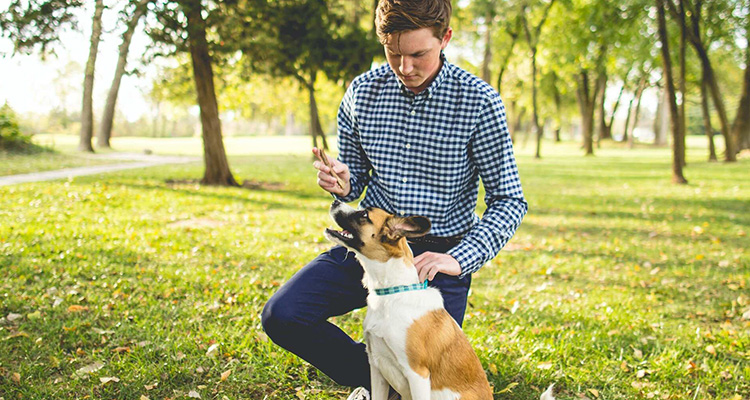
Medicine Collars:
These collars are used after surgical procedures or injuries to prevent the dog from licking or scratching the affected area. They are usually soft and comfortable, aiding in the dog’s recovery.
Anti-Bark Collars:
Who doesn’t know it? The dog barks incessantly at a passing fellow canine and won’t stop. In such cases, some dog owners turn to so-called anti-bark collars. Equipped with sensors, these collars detect the dog’s barking. They can then emit sounds, vibrations, or spray bursts to interrupt the barking and train the dog to be calmer. It might be worth a try?
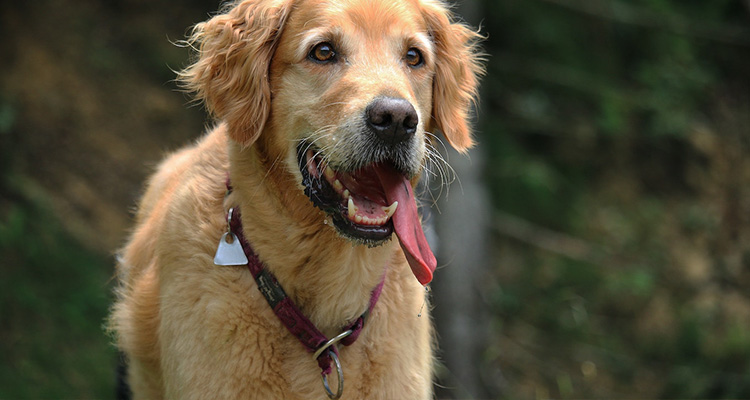
LED Collars:
LED collars provide additional safety in low light conditions or at night. They are equipped with small LED lights that make the dog visible to drivers, cyclists, or pedestrians. This can minimize the risk of accidents and injuries.
Tick and Flea Collars:
A tick collar is a specialized collar designed to deter ticks and sometimes fleas. A tick or flea collar often contains substances released continuously to keep ticks and fleas away or kill them if they approach the dog’s neck area. These substances can also penetrate the dog’s fur and repel or kill the parasites.
It is important to note that tick collars can have different active ingredients and modes of action, and the effectiveness may vary from product to product. Some tick collars release chemical agents, while others are based on natural or biological ingredients.
Quick-Release Collars:
These collars are equipped with a buckle that makes it easy to put on and take off the collar. The quick-release ensures a secure and comfortable fit and is particularly suitable for furry friends who are impatient or do not like to wear a collar.

Safety Collars:
Safety collars are specially designed to ensure the comfort and safety of the dog. They may include reflective elements, padding, and ergonomic designs to protect the dog’s neck and reduce the risk of injuries or pain.
Training collars:
These collars are often used by professional dog trainers and may include remote controls or sensors. They can emit vibrations, sounds, or electric impulses to correct or train specific behaviors. Their use requires expertise and should only be done in consultation with dog trainers.
Legal restrictions on collars
It is important to check local laws and regulations regarding dog training aids in the specific region. The use of training collars, especially those emitting electric impulses, should always be approached with extreme caution and in compliance with local laws. Generally, the use of electric impulse collars for dogs is controversial and restricted or even banned in many states. These restrictions stem from the perception that electric impulse collars may be potentially harmful to the well-being of dogs.
Laws and regulations can vary from country to country and even from state to state. In the US, the use of electric impulse collars for dog training or control is not fundamentally prohibited, but strict regulations and restrictions apply. According to American animal protection laws, causing animals unnecessary pain, suffering, or harm is prohibited, making the use of electric impulses that cause strong pain or distress illegal. If electric impulse collars are used, they must be clearly labeled and comply with animal protection laws. Moreover, in America, only trained personnel or under veterinary supervision are allowed to use electric impulse collars.
If you plan to purchase an electric collar for your dog, it is essential to thoroughly research local rules. Additionally, consider whether exposing your dog to electric shocks is necessary and explore alternative, pain-free training methods.
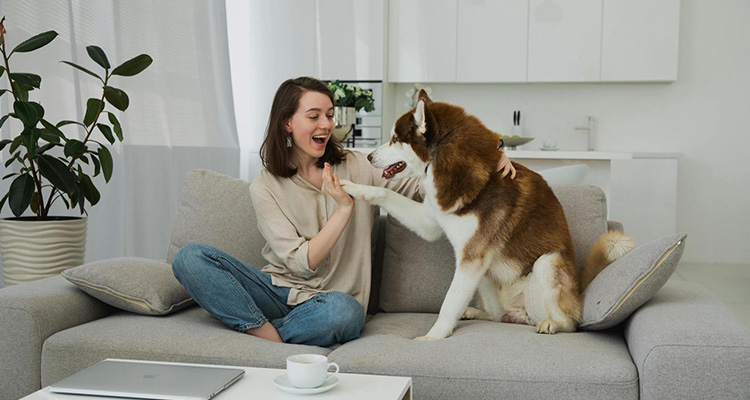
That was a brief overview of different collar types. Some collars may represent a combination of types, such as an LED and safety collar.
When is the collar fitted correctly?
Ideally, your dog’s collar should be lightweight and comfortable to wear. A good rule of thumb is that two fingers should fit between the collar and the neck. This means the collar should be snug enough not to slip off but not so tight as to cause discomfort to your dog.
Common materials for dog collars
Various materials are used in the production of dog collars. Choose a material that is comfortable and suits your lifestyle and your dog’s needs. Some materials are easy to clean, while others are durable and robust. Commonly used materials include leather, nylon, biothane, and metal.
Leather:
Leather collars are popular for their durability and comfort for dogs. High-quality leather is soft and flexible, providing a comfortable feel around the dog’s neck. Leather collars are available in various styles and sizes, suitable for both small and large dogs. One drawback of leather collars is their susceptibility to water and moisture, requiring regular maintenance to preserve their quality and appearance.

Nylon:
Nylon collars are another common option made of durable synthetic fabric. They offer advantages such as affordability, a variety of colors, and designs. Nylon collars are lightweight, comfortable, and easy to handle. Additionally, they are water-resistant and easy to clean. Despite their durability, they may show signs of wear under heavy use.
Biothane:
Biothane, being easy to clean and resistant to moisture, is excellent for use in wet or muddy environments. In appearance, it resembles leather but is more resistant to moisture. The material comes in various colors and variants, and leashes made of biothane do not absorb dirt and odors, making them easy to clean. Stylish, practical, and robust, biothane is a recommended choice.
Furthermore, biothane is excellent for long leads as they often drag on the ground and quickly become wet and dirty. Easy cleaning is a significant advantage.
Metal:
Metal collars, such as chain or prong collars, are often used as training aids or to control strong, energetic dogs. They consist of metal links or prongs joined together to form a chain or collar. One advantage of metal collars is their durability and longevity. However, they are not suitable for all dogs and should only be used with appropriate handling and training to avoid injuries or disciplinary issues.
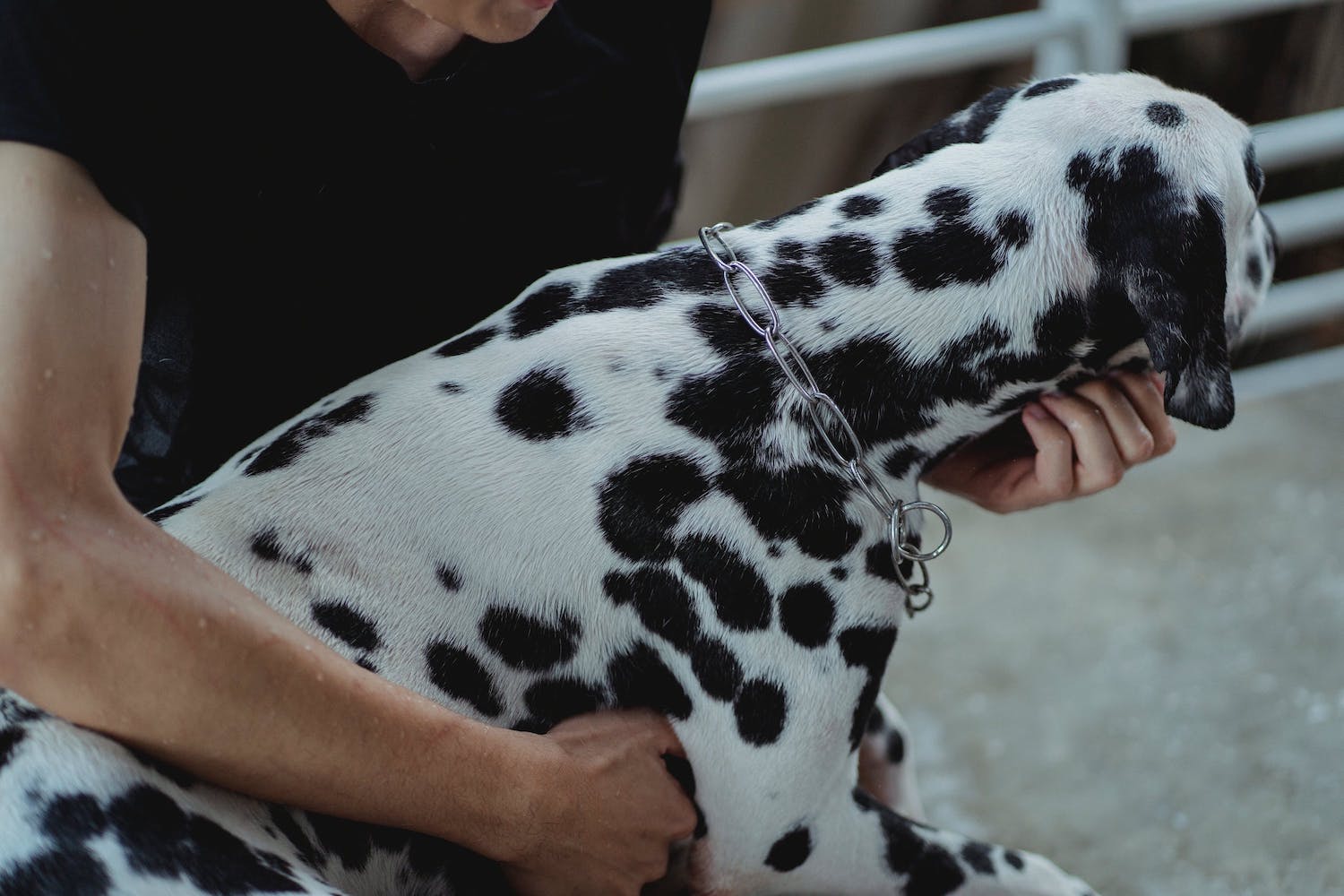
Collars are also made from other materials, such as velvet or decorated with decorative elements like rhinestones or pearls. These decorative collars mainly serve aesthetic purposes and aim to enhance the dog’s appearance.
Alternative: Harness
Perhaps you don’t want a collar at all and prefer a harness for your companion. A harness offers several advantages over a collar for both you and your dog.
A harness distributes leash tension evenly across the entire body, especially the chest area, instead of concentrating it on the neck. This is much more comfortable for your dog and reduces the risk of pain and injuries to the neck, as may occur with collars. The dog’s neck is not strained, and your pet has greater freedom of movement.
Moreover, a harness provides better control over the dog without causing choking, which is crucial for energetic dogs with strong pulling behavior. Especially for large dogs, better guidance is possible. It often facilitates training as it causes less discomfort to the dog. Special safety harnesses for car travel provide protection in case of an accident. For many dog owners, a harness is the preferred choice, particularly for dogs prone to pulling or those with health issues in the neck area.
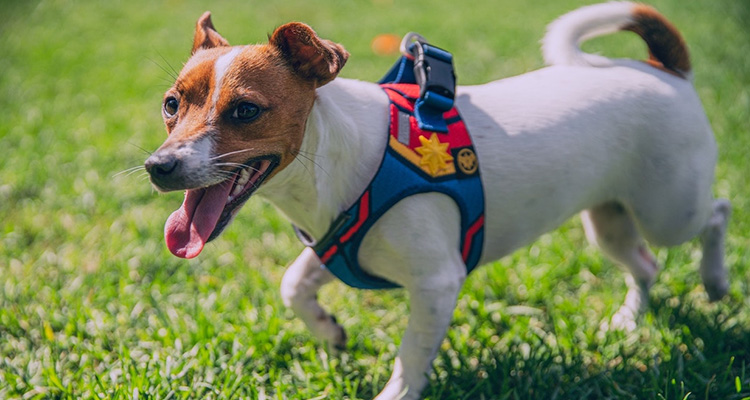
You can use the harness exclusively or in addition to a comfortable collar that your pet wears continuously, such as for walks or training sessions. Using an additional collar is advisable because you can attach useful items to it that your dog should wear even when the harness is removed. More on that below.
Useful items you can attach to a collar or harness
For additional safety, it makes sense to attach certain items to your dog’s collar. Some collars already offer attachment options, such as loops or rings, facilitating this.
Dog tags:
Similar to leashes, some states legally require you to attach a dog tag to your dog’s collar. These dog tags, also known as “dog tax tags” or “dog tax plaques,” serve as a form of identification and taxation for dogs. They are a good idea in case your dog gets lost.
You can include essential information on a dog tag. For example:
- Your contact information, including your phone number – this allows a helpful stranger who found your dog to contact you.
- Your address, a city, or a district.
- Your dog’s vaccinations.
All this information can help keep your dog safe if they wander outdoors. If someone finds your dog, they can contact you.
Microchip Tag:
If you don’t want to write your address or phone number on a dog tag, you can instead provide information that your dog has a microchip. This way, people immediately know that your furry friend can be taken to the veterinary clinic to read the chip. This means higher chances of quickly getting your beloved pet back.
LED Lights:
LED lights or flashing lights can be attached to the collar to increase the visibility of your furry friend in low-light conditions, especially during walks in the dark.
Tracking Device:
In a world where dog thefts are increasing, a tracking device is a must for many dog owners. However, it can be helpful not only in case of theft but also in various situations where dogs may run away.
Whether your dog is not well-trained, runs away at the slightest scare, or has a strong hunting instinct – with a GPS tracker, you never have to worry about losing your beloved pet again.
Which tracking device is right for me?
There are several tracking devices on the market that are not specifically designed for pets but are still used by some pet owners for their four-legged companions. These include the Samsung SmartTag or the Apple AirTag, among others. Read our two articles for an accurate product comparison.
In short, if you use a tracking device for your dog that is not specifically designed for pets, you accept some health risks and miss out on many cool features. Additionally, these devices usually only work with Bluetooth, limiting you to a very short range or relying on other users. Overall, it is a moderate to poor option.
The Tractive GPS Tracker for Dogs:
You are on the safe side with a tracker that utilizes GPS and mobile networks and is specifically designed for pets. The Tractive GPS Tracker for Dogs works on an unlimited range, allowing you to locate your dog anywhere and anytime – and in real-time.
“Similar to Bluetooth trackers, the Tractive GPS Tracker also uses Short Range Radio to determine its position. Unlike Bluetooth trackers, our tracker additionally uses GPS and mobile networks. Even when no other mobile devices are in range, the location data can be sent to the Tractive servers. For you as a Tractive user, this means that you can locate your pet live at any time independently of other people.”
– Ivelin Nenkov, Embedded Systems Engineer, at Tractive since 2016.
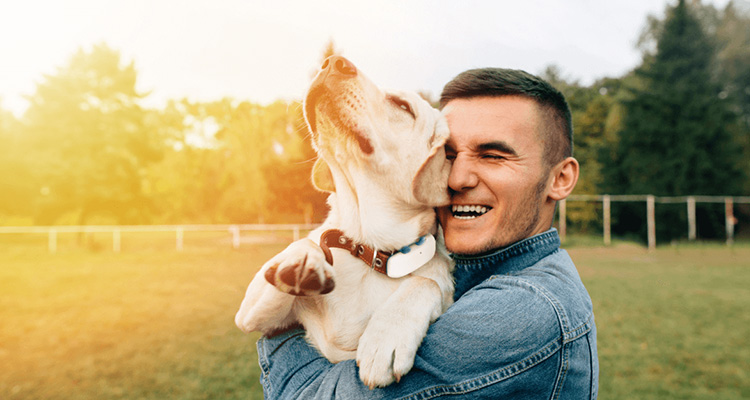
But that’s not all. In addition to live tracking, you can also monitor the fitness and health of your furry friend. All in one device! Other great features include:
- Virtual Fence: Mark safe areas (e.g., your garden) or set up a forbidden zone (e.g., the neighbor’s garden) and receive notifications when your little escape artist enters and leaves this area.
- Location History: Check where your pet has been in the last 365 days and discover all their favorite spots.
- Light and Sound: Easily find the tracker when lost.
- Energy-Saving Zones: Connect your tracker to your Wi-Fi and save battery when your pet is at home.
- Radar Mode: Find your tracker using Short Range Radio if the network connection is weak. Double security for both of you.
- Tracker Sharing: Allow friends, family, pet sitters, and others to locate with you.
- Activity and Sleep Tracking: Set goals and compare activity with similar dogs. Recognize sleep patterns and discover potential health issues early on.
- Health Warnings: Be instantly informed if your furry friend’s activity data deviates from their average values. This way, you can prevent potential health problems.
“For us, pets and their owners come first. Our tracker combines several functions, from GPS tracking to wellness tracking. So, our product provides an excellent way to keep four-legged friends safe and healthy.”
– Sebastian Raab, Product Manager at Tractive & occasional pet sitter.
Conclusion
Now that you are familiar with the different types of dog collars, you are one step closer to ensuring the safety and well-being of your dog. Whichever you choose – as long as it is comfortable for your furry friend to wear and simultaneously safe, you are on the right track. Also, consider adding extra security by attaching a dog tag, LED lights, and/or a GPS tracker to the collar. This way, (almost) nothing can go wrong.
Do you have a friend or a loved one who has just adopted a new dog? Share this article with them and help them start their journey as pet owners!


